Different Views
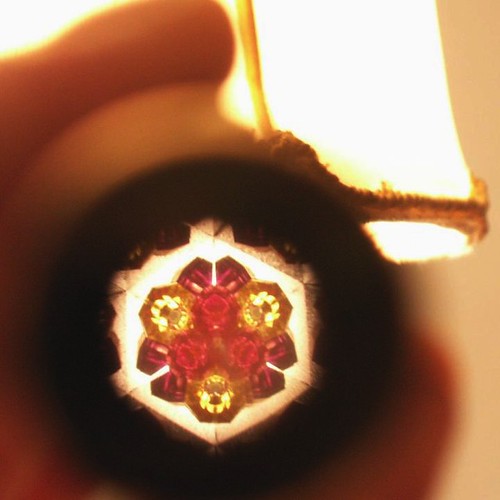
About 15 years ago a friend gave me a wondrous brass kaleidoscope made by Van Cort Instruments. The kaleidoscope measures 5-1/4 inches long, with a half-inch diameter barrel.
Here I hold it up to the light of my desk lamp, which once belonged to my grandmother and which my mother had used in her work room. That room is now my studio. (The lamp's blue marbled base can be seen here.)
The design inside the barrel seemed to me a good companion for a photo I'd taken weeks earlier and knew I'd find a use for some day....
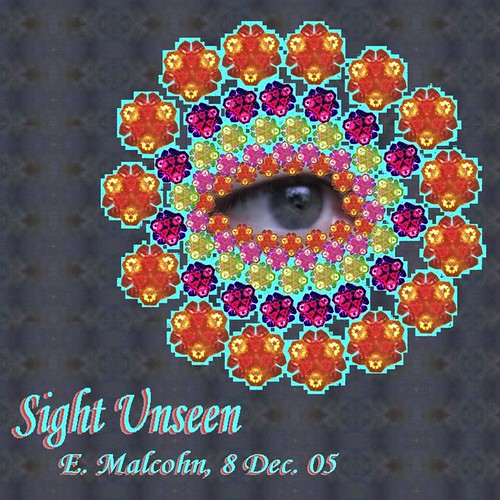
During Mary's last visit to the optometrist I sat in the waiting room listening to a couple of women talk about blue eyes. Eventually they came over to my chair.
"Excuse me," the older one said. "Could we look at your eyes for just a minute?"
I gazed up, let them peer at me.
"Oh yeah." The older woman nodded. "That's blue." They thanked me quickly and were on their way.
I wondered if they were looking for tinted contact lenses. I had never taken a really close look at my eye color until that incident, but what better way to do so than with a camera? Standing before our roughly southeast-facing window, I held the lens up to my face and clicked.
A section of my iris, copied and rotated, forms the background to this piece. Surrounding my eye are original and color-altered images made by the kaleidoscope.
I'd been told -- first when I was in high school, then several times subsequently -- that my eyes change color. Not dramatically. But depending on the light level (I suppose), or the clothes I'm wearing, sometimes they're a little bluer, or greener, or grayer. My father's eyes had been blue, my mother's hazel. Mary's eyes are colored similarly to mine -- though when she came in with a question while I typed these comments I noticed they were a little lighter and a little greener as she stood by my desk lamp.
We've been having rain, so my outdoor shots have been few. The photos I don't post -- either because I think they repeat already-posted shots or they don't excite me enough -- can still yield collage-worthy components.
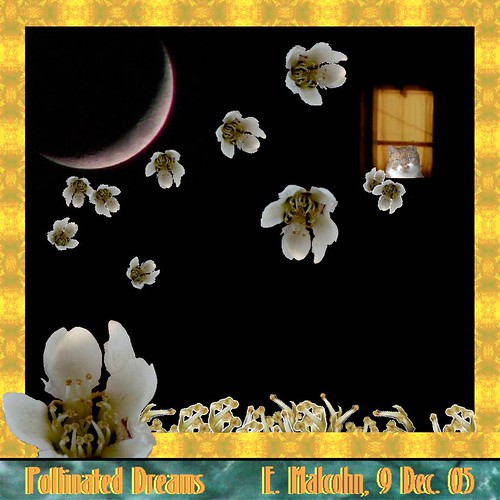
Most of the components here are from unposted photos. The moon is one exception. The yellow border design is a several-times color-altered variation of the background used in "Sight Unseen."
I've posted a picture of a loquat flower, but the one here is from a different shot. Red was staring out a window, just not this one, which is part of a neighbor's house and is from one of my first nighttime, tripod-assisted shots. The blue at the bottom is rain puddled on the cover of our teal tub out back, in a photo I took on the same day as "Water Ballet."
The rain hasn't stopped our walks, though. Recently we spotted a species of duck we hadn't before seen up close (well, some distance away) and personal.
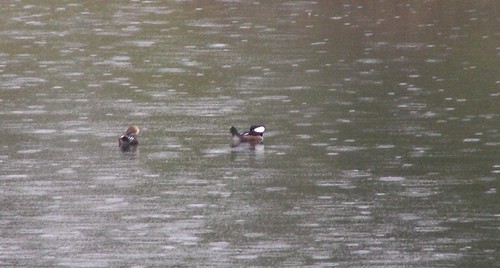
These are Hooded Mergansers -- subfamily Merginae, Lophodytes cucullatus, 16-19 in. (40-48 cm.). A female is on the left, male on the right. Mergansers are diving ducks, feeding chiefly on small fish. (Clicking on the image will bring up a slightly larger view; more detail can be seen here.)
We were already experiencing a light drizzle when we set out to do errands on foot. By the time we reached the "post office pond" we had a steady rain that grew ever heavier. Like the ducks, we were hooded. I'd whipped out my camera for five quick shots, shielding it from the rain as best I could and thankful for my water-resistant carrying case that kept it dry.
"They remind me of buffleheads," Mary said as we continued on. Sure enough, bufflehead ducks are cited as a "similar species" in our Peterson Field Guide to the Birds of Eastern and Central North America, though they are chubbier, considerably smaller, and have white sides. Up in Boston we'd often watched the buffleheads, also diving ducks, in Dorchester Bay.
The fan-shaped white crest on hooded mergansers can be raised or lowered; the female's crest is tawny. They winter throughout Florida and along the Gulf and northern Mexico, though their winter range also extends up the Atlantic U.S. coast as far north as Massachusetts. On rare occasion they'll winter in the Great Lakes or Maine. Hardy birds.
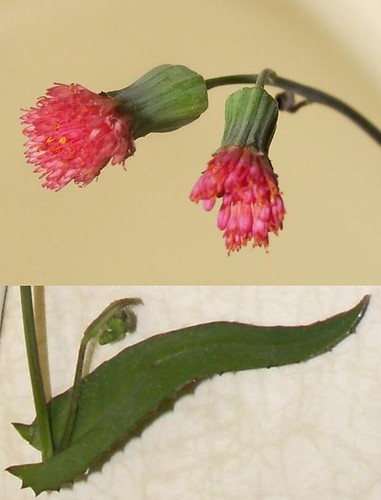
Mary plucked this flower to bring to the plant clinic at our library. We're still trying to identify it, though judging from a note left on Flickr it also grows in Brazil. Here it dots our front yard and elsewhere, and had found favor with the Queen butterfly I photographed last month. Erigeron seems to come close, from what we could find in Martyn Rix's The Random House Book of Perennials, but it doesn't seem to come close enough.
The sky was clear that night; after photographing the plant in our bathroom I ducked outside for some moon shots.
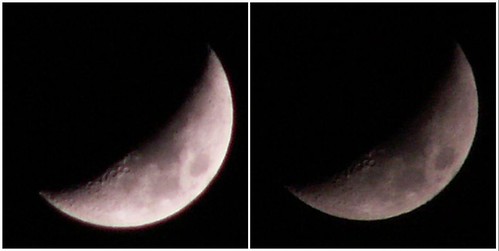
The exposure on the left shows more detail at the terminator; that on the right shows more detail at the limb. Eventually I'll get into the habit of recording the settings I use for these -- probably take a microcassette recorder with me and recite as I go along. These represent the 14th and 18th shots.
Once I got back inside, Mary wanted me to take more pictures of our mystery flower, which she's taken to calling Dragon's Blood Daisies. The stalk was still in the bathroom. Afterwards I figured What the hey, let's do a mirror shot.
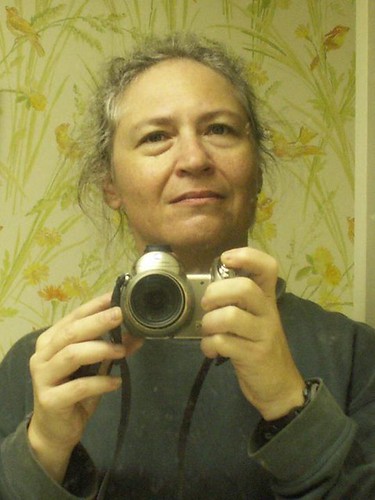
The camera I'm holding is a Konica-Minolta DiMAGE Z6. The small, faint, straight-line scars on my cheeks (more visible in the larger size) are likely the oldest ones I bear. My mother had told me that a certain type of forceps had come into use not long before I was born and that their use had spared her a Caesarian. The scars are from the forceps.
The wallpaper behind me dates from when this house had been built for my parents in 1980.











1 Comments:
That is so cool. I especially like the kalidescope shot with the eye. My cameral is SO rudimentary compared to yours. I admire your photo shop collage abilities.
You're right about the scrabble box looking like a pizza box!
Post a Comment
<< Home